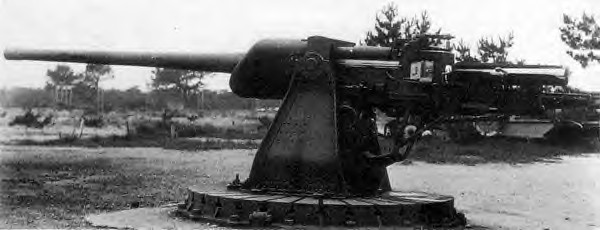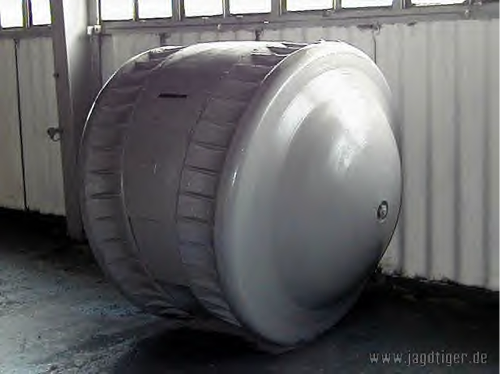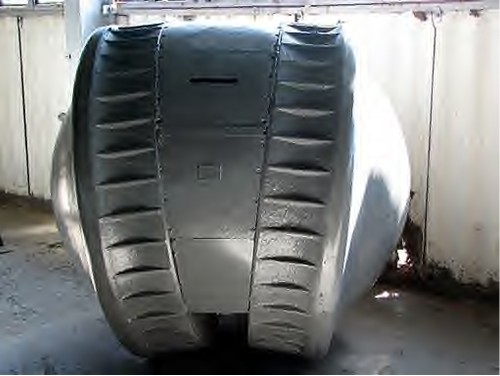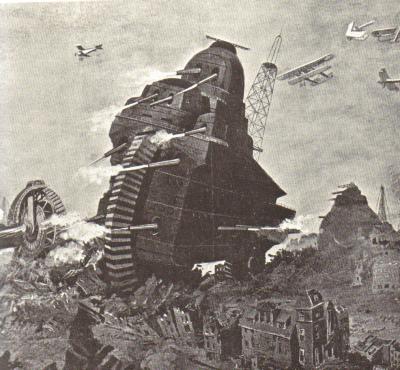
Japanese strange vehicles
Moderators: Joel Billings, wdolson, Don Bowen, mogami
RE: Japanese strange vehicles
We now know what Brady wants for Christmas.
Bill
Bill
WitP AE - Test team lead, programmer


RE: Japanese strange vehicles
Looks like a Russain T-35 land battleship on steroids
"The difference between genius and stupidity is that genius has limits"- Darwin Awards 2003
"No plan survives contact with the enemy." - Field Marshall Helmuth von Moltke
[img]https://www.matrixgames.com/forums/upfi ... EDB99F.jpg[/img]
"No plan survives contact with the enemy." - Field Marshall Helmuth von Moltke
[img]https://www.matrixgames.com/forums/upfi ... EDB99F.jpg[/img]
-
Mike Scholl
- Posts: 6187
- Joined: Wed Jan 01, 2003 1:17 am
- Location: Kansas City, MO
RE: Japanese strange vehicles
Looks to me like someone at the IJA's Tank Design Bureau has been smokin' funny cigarettes again... I'm sure the Japanese Motor Vehicle Industry could turn out one of those per year with three years of re-tooling to start. Should have one by 1947
RE: Japanese strange vehicles
Hi all,
Shame on you... [:D]
This vehicle is perfoect for jungle warfare - it is small, maneouverable and easily transportable! [8D]
Leo "Apollo11"
ORIGINAL: Mike Scholl
Looks to me like someone at the IJA's Tank Design Bureau has been smokin' funny cigarettes again... I'm sure the Japanese Motor Vehicle Industry could turn out one of those per year with three years of re-tooling to start. Should have one by 1947
Shame on you... [:D]
This vehicle is perfoect for jungle warfare - it is small, maneouverable and easily transportable! [8D]
Leo "Apollo11"

Prior Preparation & Planning Prevents Pathetically Poor Performance!
A & B: WitW, WitE, WbtS, GGWaW, GGWaW2-AWD, HttR, CotA, BftB, CF
P: UV, WitP, WitP-AE
- wild_Willie2
- Posts: 2934
- Joined: Fri Oct 08, 2004 10:33 am
- Location: Arnhem (holland) yes a bridge to far...
RE: Japanese strange vehicles
[font=arial]The Japanese O-I experimental super heavy tank had three turrets and weighed 120 tons, more than any of the German Tiger tanks, but less than the [/font][font=arial]188 ton Maus or rival 140 ton E-100[/font][font=arial]. [/font]
It was 10 meters long by 4.2 meters wide with an overall height of 4 meters. The armor was 200 mm (8 inches) at its maximum. The tank had a top speed of 25 km/h (15 mph) and was crewed by eleven men!
This first version had two 12 cylinder gasoline engines each developing 550 PS @ 1500 rpm.
For armament, the O-I had a massive105 mm main gun believed to be a redesigned Type 92 artillery gun which weighed five tons, forcing a redesign of the O-I main turret for accommodation . The tank also had a Type 1 37 mm in a forward mounted sub turret and three Type 97 7.7 mm machine guns (one mounted in a forward sub turret) whereas another experimental version also mounted a Type 1 37 mm in a rear facing sub turret.

Type 97 tank machine gun
The O-I would carry 60 rounds for the 105mm gun, 100 rounds for the 37mm gun, and a total of 7,470 rounds for the three machine guns!
It has been reported that a single copy of the O-I was manufactured before the end of the war and was shipped to Manchuria, according to an engineer concerned with the project. Generally unknown, the O-I is a mystery like the Krupp Kugelpanzer similarly shipped to Manchuria in 1945.
No photos of the O-I have been discovered; only some drawings are known to exist. All images of the tanks are strictly provisional.

5 ton Type 92 105mm artillery gun
Type 92 105mm Main Gun Data:[/b]
Caliber: 104.9 mm
Barrel length: 4,720 mm
Muzzle velocity: 900 m/sec
Grooves: 32
Spin direction: right
Ammunition:
Projectile: 16 kg
Propellant charge: 30 kg
Penetration: 150 mm at 1,000 meters
O-I EXPERIMENTAL ULTRA-HEAVY TANK

The O-I Experimental Ultra Heavy Tank was a modification of the standard O-I Super Heavy Tank and had 4 turrets but is not believed to have been completed by V-J Day.
It was 10 meters long by 4.2 meters wide with an overall height of 4 meters. The armor was 200 mm (8 inches) at its maximum. The tank had a top speed of 25 km/h (15 mph) and was crewed by eleven men!
This first version had two 12 cylinder gasoline engines each developing 550 PS @ 1500 rpm.
For armament, the O-I had a massive105 mm main gun believed to be a redesigned Type 92 artillery gun which weighed five tons, forcing a redesign of the O-I main turret for accommodation . The tank also had a Type 1 37 mm in a forward mounted sub turret and three Type 97 7.7 mm machine guns (one mounted in a forward sub turret) whereas another experimental version also mounted a Type 1 37 mm in a rear facing sub turret.

Type 97 tank machine gun
The O-I would carry 60 rounds for the 105mm gun, 100 rounds for the 37mm gun, and a total of 7,470 rounds for the three machine guns!
It has been reported that a single copy of the O-I was manufactured before the end of the war and was shipped to Manchuria, according to an engineer concerned with the project. Generally unknown, the O-I is a mystery like the Krupp Kugelpanzer similarly shipped to Manchuria in 1945.
No photos of the O-I have been discovered; only some drawings are known to exist. All images of the tanks are strictly provisional.

5 ton Type 92 105mm artillery gun
Type 92 105mm Main Gun Data:[/b]
Caliber: 104.9 mm
Barrel length: 4,720 mm
Muzzle velocity: 900 m/sec
Grooves: 32
Spin direction: right
Ammunition:
Projectile: 16 kg
Propellant charge: 30 kg
Penetration: 150 mm at 1,000 meters
O-I EXPERIMENTAL ULTRA-HEAVY TANK

The O-I Experimental Ultra Heavy Tank was a modification of the standard O-I Super Heavy Tank and had 4 turrets but is not believed to have been completed by V-J Day.
In vinum illic est sapientia , in matera illic est vires , in aqua illic es bacteria.
In wine there is wisdom, in beer there is strength, in water there are bacteria.
In wine there is wisdom, in beer there is strength, in water there are bacteria.
- wild_Willie2
- Posts: 2934
- Joined: Fri Oct 08, 2004 10:33 am
- Location: Arnhem (holland) yes a bridge to far...
RE: Japanese strange vehicles
Will THIS be in AE???
KRUPP KUGELPANZER
(1945)
[font=arial]By Rob Arndt
[/font]
[font=arial] [/font]
[/font]
 [center]
[center]
Side view of one of two hemispherical disc-shaped armored wheels
located on each side of the Kugelpanzer [/center] 
Rear view of the connection point between the hull and
directional steering wheel of the Kugelpanzer

[font=arial][/font]
Close up view of the directional steering wheel of the Kugelpanzer
Photos courtesy of www.jadgpanzer.de
[right] [/right]
[font=arial]The Kugelpanzer literally translates as “Ball Tank” and is the most rare and strange armored fighting vehicle ever built. Only one lone example of this Reconnaissance Rollzeug (Rolling Vehicle) has been captured by the Russians and it survives today as part of the [/font]Kubinka Museum’s collection of German armored vehicles. The Kugelpanzer is simply listed as Item #37 and has been painted over gloss white. From fragmentary information sources, the drive has been removed from the vehicle and no metal samples are allowed taken from it. The history of the vehicle is literally unknown, as no documents were found with it and the vehicle had no clear markings. Only six firm facts are available:
1) The Kugelpanzer was a German-made vehicle shipped to Japan via technology transfer
2) The Kugelpanzer was a light Reconnaissance AFV
3) The Kugelpanzer was captured by the Russian Army in 1945 in Manchuria
4) The Kugelpanzer was plated with only 5mm of armor on its hull
5) The Kugelpanzer was powered by a single cylinder two-stroke engine
6) The Kugelpanzer was operated by one person
It is hard to speculate on how this machine functioned, but from observation it appears to be a one man reconnaissance tank with an armored shell and view port. Perhaps under or behind the operator an engine was mounted and for stability a small directional wheel was located at the rear to steer the two large hemispherical disc tracks at the sides. When not on the move, the Kugelpanzer would become an armored shelter or perhaps a pillbox “if” any weapon could be fired from it. It is not clear from photographic evidence if a firing port was located under the view port. Since this vehicle had come from Germany, then the primary armament of this vehicle would have probably been a German 7.92mm MG-34 or MG-42 machine gun. Japanese machine guns were poorly manufactured and functioned badly in the field along with their single type of submachine gun in production. From photographic evidence it appears that this single machine was captured fully intact, having seen no combat at all.
It is also widely speculated that only Krupp could have built this machine.
[align=center]
As the war progressed, the Germans found themselves increasingly trading their high technology for very little in return other than the prospect of stiffening Japanese resistance and perhaps drawing American force to the Pacific and lessening pressure on the Reich. And the Japanese, their industry hard-pressed to maintain pace with American and British technological developments, were always very eager, and very specific, in their demands for high technology from their Aryan brethren.
Even the conventional military technology transfers form Germany to Japan are staggering enough.
By 1944 Japan had requested and received either working models or full production designs for the following:
German techniques for manufacturing cartridge steel for large gun barrel linings; [/align]
Finished artillery pieces; [/align]
105 and 128 mm heavy anti-aircraft (FLAK) guns; [/align]
the 75 and 88 mm field pieces and anti-tank guns; [/align]
the Würzburg radar system; [/align]
750 ton submarine pressure hulls; [/align]
the PzKw Via Tiger I tank; [/align]
the Focke Wulfe 190 fighter; [/align]
the Henschel 129 tank-busting aircraft [This rather odd-looking twin engine aircraft had a bulbous cupola slung beneath the nose of the main fuselage, in which was mounted a 75mm automatically reloading high velocity anti-tank gun projecting from its nose. It was a deadly and efficient tank-busting airplane used with great effectiveness on the Eastern Front, curiously resembling a similar ground assault aircraft in the modern American arsenal, the A-10 "Warthog"]; [/align]
the Heinkel He 177 heavy bomber; [/align]
the Messerschmitt 264 long-range Amerikabomber; [/align]
the Messerschmitt 262 jet fighter; [/align]
the Messerschmitt 163 rocket-powered fighter; [/align]
the Lorenz 7H2 bombsight; the B/3 and FUG 10 airborne radars;[/align]
·
Fortunately for American and Commonwealth forces in the Pacific theater, these weapons never saw full scale production by the Japanese. What is intriguing is the last item. Why bomb fuses? Surely the Japanese, who had been raining bombs all over China, Indochina, Burma, and the Pacific knew how to fuse a conventional bomb. The request suggests that the fuses were of sophistication beyond the capabilities of Japanese industry. And why a request for heavy bombers so close to the end of the war, at least one of which was reputedly capable of ultra-long-range flight and heavy payload?
~ Joseph Mark Scalia, Germany's Last Mission to Japan: [font=arial]The Failed Voyage of the U-234
[/font]
[font=arial]
[/font]

[/size][/align]
War Tank on One Wheel Operated By One Man [/b]
POPULAR SCIENCE
November 1933[/align]US Army 'Tumbleweed' Ball Tank Design
POPULAR SCIENCE
[font=arial]July 1936
[/font]

[font=arial]
[font=arial]
[font=arial]
[font=arial] [/font]
[/font]
[font=arial]Kugelpanzer Predecessor of WW1
[/font][/font]
[font=arial]By request of the German War Ministry, an armored vehicle project put forward in 1916-1917 to the German commercial firm of the Bremen Hansa-Lloyd Works. They were to design a battlewagon, [/font]Germany's one and only “big wheel” design, which progressed further than its British counterpart.
The Treffas-Wagen was finished on February 1, 1917. It had two large steel wheels, roughly 11 feet in diameter, on each side of a rectangular armoured body. At the rear was a large castor-like roller for steering. In front of the body was a 20 mm TUF gun, with machine guns on either side for firing into trenches. The crew consisted of four men. The Treffas-Wagen weighed 18 tons. One prototype was built, and thoroughly tested during February and March of 1917.
Meanwhile, a decision was made in favor of the A7V. The Treffas-Wagen was not developed any further and was dismantled in October of 1917.

[center]

[/font][/center]
[font=arial][center]
[/center]
Schumann Panzerlafette / Fahrpanzer
The Fahrpanzer (mobile shielding) was conceived in Germany at the beginning of the century like a mobile fortification: one could move the turret into any tactical position as a blockhouse for attacking enemy infantry long before opposing artillery showed up. The machine was not autonomous and would have to be put into position by a motorized transport... or a horse-drawn wagon. This kind of machine was used at the height of Metz, but was to be largely exported. The viability of the concept however, was always in doubt: no motorization left the machine without autonomy and it lacked internal ammunition reserves. The recoil of the 50mm gun also tended to destabilize the machine badly.The only specimen of this armored curiosity is preserved at the Royal Army Museum of Brussels where the photographs originate.







[/font]
[font=arial]A7V
The first German battle tank, 1917
[/font]



[/font][/align]
[/align]
[font=arial]
[font=arial]
 Russian Wheel Tank of WW1
Russian Wheel Tank of WW1
The bizarre "Tsar-tank" was built in 1915. At 40 tons, it was probably the largest tank ever made anywhere at the time. Two huge wheels were driven by one 250 hp motor each. Two minor wheels were to the rear. The guns were probably placed outside the wheels. Two prototypes were made, but the insufficient trial (stuck in the mud) and heavy costs closed the project in 1916. The last of the two was [font=arial]dismantled for scrap in 1923.
[/font]



 [/font]
[/font]
[center]
Russian Tank of the Future Concept
[/center][/font]
[font=verdana][font=arial]STRANGE VEHICLES OF PRE-WAR [/b]GERMANY[/b] & THE THIRD REICH (1928-1945)[/b]
 [/b]
[/b]
[/font][/b][/font][font="times new roman"] [/font]
KRUPP KUGELPANZER
(1945)
[font=arial]By Rob Arndt
[/font]
[font=arial]
 [/font]
[/font] [center]
[center]
Side view of one of two hemispherical disc-shaped armored wheels
located on each side of the Kugelpanzer [/center]

Rear view of the connection point between the hull and
directional steering wheel of the Kugelpanzer

[font=arial][/font]
Close up view of the directional steering wheel of the Kugelpanzer
Photos courtesy of www.jadgpanzer.de
[right] [/right]
[font=arial]The Kugelpanzer literally translates as “Ball Tank” and is the most rare and strange armored fighting vehicle ever built. Only one lone example of this Reconnaissance Rollzeug (Rolling Vehicle) has been captured by the Russians and it survives today as part of the [/font]Kubinka Museum’s collection of German armored vehicles. The Kugelpanzer is simply listed as Item #37 and has been painted over gloss white. From fragmentary information sources, the drive has been removed from the vehicle and no metal samples are allowed taken from it. The history of the vehicle is literally unknown, as no documents were found with it and the vehicle had no clear markings. Only six firm facts are available:
1) The Kugelpanzer was a German-made vehicle shipped to Japan via technology transfer
2) The Kugelpanzer was a light Reconnaissance AFV
3) The Kugelpanzer was captured by the Russian Army in 1945 in Manchuria
4) The Kugelpanzer was plated with only 5mm of armor on its hull
5) The Kugelpanzer was powered by a single cylinder two-stroke engine
6) The Kugelpanzer was operated by one person
It is hard to speculate on how this machine functioned, but from observation it appears to be a one man reconnaissance tank with an armored shell and view port. Perhaps under or behind the operator an engine was mounted and for stability a small directional wheel was located at the rear to steer the two large hemispherical disc tracks at the sides. When not on the move, the Kugelpanzer would become an armored shelter or perhaps a pillbox “if” any weapon could be fired from it. It is not clear from photographic evidence if a firing port was located under the view port. Since this vehicle had come from Germany, then the primary armament of this vehicle would have probably been a German 7.92mm MG-34 or MG-42 machine gun. Japanese machine guns were poorly manufactured and functioned badly in the field along with their single type of submachine gun in production. From photographic evidence it appears that this single machine was captured fully intact, having seen no combat at all.
It is also widely speculated that only Krupp could have built this machine.
[align=center]
As the war progressed, the Germans found themselves increasingly trading their high technology for very little in return other than the prospect of stiffening Japanese resistance and perhaps drawing American force to the Pacific and lessening pressure on the Reich. And the Japanese, their industry hard-pressed to maintain pace with American and British technological developments, were always very eager, and very specific, in their demands for high technology from their Aryan brethren.
Even the conventional military technology transfers form Germany to Japan are staggering enough.
By 1944 Japan had requested and received either working models or full production designs for the following:
German techniques for manufacturing cartridge steel for large gun barrel linings; [/align]
Finished artillery pieces; [/align]
105 and 128 mm heavy anti-aircraft (FLAK) guns; [/align]
the 75 and 88 mm field pieces and anti-tank guns; [/align]
the Würzburg radar system; [/align]
750 ton submarine pressure hulls; [/align]
the PzKw Via Tiger I tank; [/align]
the Focke Wulfe 190 fighter; [/align]
the Henschel 129 tank-busting aircraft [This rather odd-looking twin engine aircraft had a bulbous cupola slung beneath the nose of the main fuselage, in which was mounted a 75mm automatically reloading high velocity anti-tank gun projecting from its nose. It was a deadly and efficient tank-busting airplane used with great effectiveness on the Eastern Front, curiously resembling a similar ground assault aircraft in the modern American arsenal, the A-10 "Warthog"]; [/align]
the Heinkel He 177 heavy bomber; [/align]
the Messerschmitt 264 long-range Amerikabomber; [/align]
the Messerschmitt 262 jet fighter; [/align]
the Messerschmitt 163 rocket-powered fighter; [/align]
the Lorenz 7H2 bombsight; the B/3 and FUG 10 airborne radars;[/align]
·
Fortunately for American and Commonwealth forces in the Pacific theater, these weapons never saw full scale production by the Japanese. What is intriguing is the last item. Why bomb fuses? Surely the Japanese, who had been raining bombs all over China, Indochina, Burma, and the Pacific knew how to fuse a conventional bomb. The request suggests that the fuses were of sophistication beyond the capabilities of Japanese industry. And why a request for heavy bombers so close to the end of the war, at least one of which was reputedly capable of ultra-long-range flight and heavy payload?
~ Joseph Mark Scalia, Germany's Last Mission to Japan: [font=arial]The Failed Voyage of the U-234
[/font]
[font=arial]
[/font]

[/size][/align]
War Tank on One Wheel Operated By One Man [/b]
POPULAR SCIENCE
November 1933[/align]US Army 'Tumbleweed' Ball Tank Design
POPULAR SCIENCE
[font=arial]July 1936
[/font]

[font=arial]
[font=arial]
[font=arial]
[font=arial]
 [/font]
[/font][font=arial]Kugelpanzer Predecessor of WW1
[/font][/font]
[font=arial]By request of the German War Ministry, an armored vehicle project put forward in 1916-1917 to the German commercial firm of the Bremen Hansa-Lloyd Works. They were to design a battlewagon, [/font]Germany's one and only “big wheel” design, which progressed further than its British counterpart.
The Treffas-Wagen was finished on February 1, 1917. It had two large steel wheels, roughly 11 feet in diameter, on each side of a rectangular armoured body. At the rear was a large castor-like roller for steering. In front of the body was a 20 mm TUF gun, with machine guns on either side for firing into trenches. The crew consisted of four men. The Treffas-Wagen weighed 18 tons. One prototype was built, and thoroughly tested during February and March of 1917.
Meanwhile, a decision was made in favor of the A7V. The Treffas-Wagen was not developed any further and was dismantled in October of 1917.

[center]


[/font][/center]
[font=arial][center]

[/center]
Schumann Panzerlafette / Fahrpanzer
The Fahrpanzer (mobile shielding) was conceived in Germany at the beginning of the century like a mobile fortification: one could move the turret into any tactical position as a blockhouse for attacking enemy infantry long before opposing artillery showed up. The machine was not autonomous and would have to be put into position by a motorized transport... or a horse-drawn wagon. This kind of machine was used at the height of Metz, but was to be largely exported. The viability of the concept however, was always in doubt: no motorization left the machine without autonomy and it lacked internal ammunition reserves. The recoil of the 50mm gun also tended to destabilize the machine badly.The only specimen of this armored curiosity is preserved at the Royal Army Museum of Brussels where the photographs originate.







[/font]
[font=arial]A7V
The first German battle tank, 1917
[/font]



[/font][/align]
[/align]
[font=arial]
[font=arial]
 Russian Wheel Tank of WW1
Russian Wheel Tank of WW1
The bizarre "Tsar-tank" was built in 1915. At 40 tons, it was probably the largest tank ever made anywhere at the time. Two huge wheels were driven by one 250 hp motor each. Two minor wheels were to the rear. The guns were probably placed outside the wheels. Two prototypes were made, but the insufficient trial (stuck in the mud) and heavy costs closed the project in 1916. The last of the two was [font=arial]dismantled for scrap in 1923.
[/font]



 [/font]
[/font][center]

Russian Tank of the Future Concept
[/center][/font]
[font=verdana][font=arial]STRANGE VEHICLES OF PRE-WAR [/b]GERMANY[/b] & THE THIRD REICH (1928-1945)[/b]
 [/b]
[/b][/font][/b][/font][font="times new roman"] [/font]
In vinum illic est sapientia , in matera illic est vires , in aqua illic es bacteria.
In wine there is wisdom, in beer there is strength, in water there are bacteria.
In wine there is wisdom, in beer there is strength, in water there are bacteria.
RE: Japanese strange vehicles
ORIGINAL: Mike Scholl
Looks to me like someone at the IJA's Tank Design Bureau has been smokin' funny cigarettes again... I'm sure the Japanese Motor Vehicle Industry could turn out one of those per year with three years of re-tooling to start. Should have one by 1947
Plus set to zero its aircraft and shipbuilding industry
Interdum feror cupidine partium magnarum Europae vincendarum










